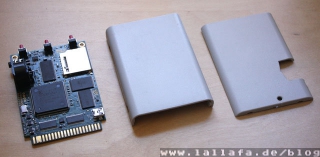Its getting colder outside and its time for cool retro projects!
Today I had a really fine idea on how to better store all the SD cards I have lying around here on my desk…
With lots of retro projects using SD card as primary storage media I have lots of them here on my desk (e.g. for sd2iec, Chameleon 64, some Raspberry Pis, Arduinos …). All are usually shipped with their crystal plastic cases that also take up space…In daily use most of them are piled on the desk and the cases fly around somewhere else. So I really needed something to clean up this mess a bit.
Today, I copied some 5.25 inch diskettes for my real C64 machine and while storing the floppy disks back in the floppy disk box, I had an idea… why no build a disk box for SD cards? 🙂
After some hours of paper work the job was done:
If you want to build your own SD card disk box: Here are some hints:
- Basic housing was the packaging of a SAM 256 uController from Olimex
- I cut away the top cover and used the spare cardboard to model the separator in the middle
- Finally I completely covered the box with self-adhesive plastic foil (Here in germany its called d c fix)
- The foldaway dividers were cut out from SD card packaging (its a mixture of cardboard and plastic foil and its really durable) and stuck into a ground plate so you can move them a bit.
Now, its on to you! Prepare your scissors and start the paper hacking today 🙂
BTW: Another retro paperware project fits very well with this project: There is a thread on Forum64 that describes how to build scale replicas of 5.25 disk sleeves for your SD cards. See this thread for details and also downloadable PDFs with the sheets of construction paper…









